The procurement function is at the forefront of a company’s efforts to address supply chain disruptions. Geopolitical tensions, soaring inflation, climate disasters, and technological complexity have made today’s business environment more volatile than ever. Companies are relying on their procurement functions to anticipate and mitigate risks and turn them into competitive advantages.
To meet the challenges, chief procurement officers and other procurement leaders must be prepared to adapt quickly. This begins with understanding the trends that are shaping the future of procurement. Leaders must continuously monitor these developments, evaluate their impact on supply availability and costs, and use this information to support strategic decision-making at the corporate level.
Our work with leading organizations worldwide has revealed seven trends that will shape the future of procurement.
Trend #1: Geopolitical Tensions and Conflicts Are Elevating Risks
Recent adversity in the global geopolitical landscape has profoundly affected commercial operations. US-China trade tensions, the COVID-19 pandemic, and Russia’s invasion of Ukraine are expected to leave lasting impacts on markets and economies. The persistence and magnitude of the risks are reflected in the elevated levels of BlackRock’s Geopolitical Risk Indicator in recent
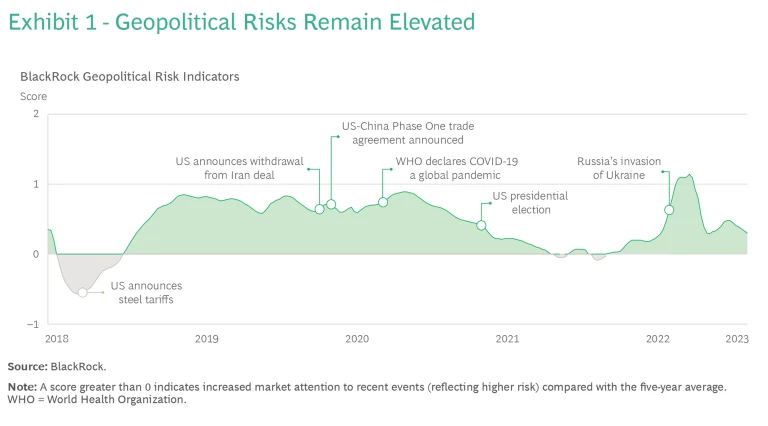
What it means for procurement. Geopolitical tensions and conflicts directly affect procurement. The impacts include operational disruptions, decreased supply chain efficiency, higher production costs, reduced output, trade route blockages, and elevated freight costs. Companies also must cope with stricter trade regulations and international sanctions.
To maintain business continuity, procurement leaders must actively monitor and manage their exposure to geopolitical risks. For example, the war in Ukraine led to shortages of neon gas, causing prices to skyrocket by as much as 5,000% compared with pre-invasion levels. This commodity is used in semiconductor production for laser etching compact circuits, making it one of many input factors contributing to the worldwide semiconductor supply shortages.
Responding to such challenges requires investing in diversifying production capabilities and de-risking supply chains. Strategies include M&A, capital expenditures, or advanced capacity planning through careful supplier management. Procurement functions need to closely collaborate with their cross-functional peers and suppliers to identify and implement such strategies.
Trend #2: Natural Disasters Are Occurring More Often
The number of natural disasters has increased five-fold over the past 50 years due to climate change and the growing frequency of extreme weather events, according to a report by the World Meteorological Organization and the UN Office for Disaster Risk Reduction
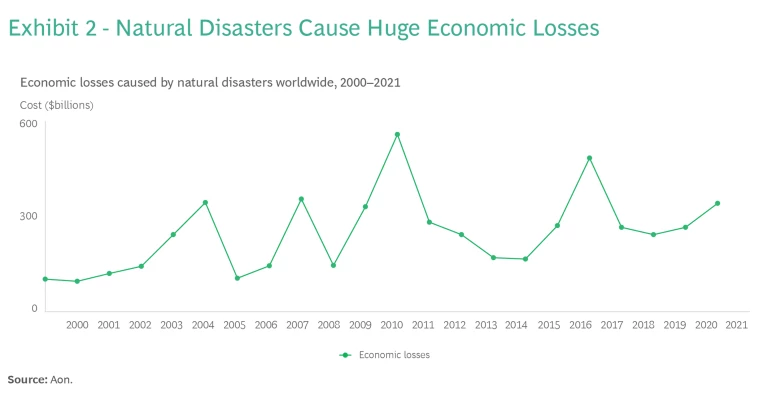
And the enormous economic costs are clear. An analysis by Aon estimated that natural disasters resulted in worldwide economic losses totaling $343 billion from 2000 through
What it means for procurement. Natural disasters can severely harm commercial property, assets, and raw materials. Procurement functions must help to mitigate the associated risks to resource availability, shipping, and the speed and quality of production. Potential actions include ensuring supply continuity, such as building redundancy for sourcing and manufacturing locations to reduce reliance on a single supply chain.
Trend #3: Inflation and a Looming Recession Are Causing Uncertainty
Although the US inflation rate trended downward after hitting a 40-year high of 9.1% in June 2022, higher costs of materials, goods, and services continue to cause businesses to curtail
The International Monetary Fund’s most recent World Economic Outlook forecasts the cost of goods to remain high in 2023, owing to a delayed pass-through of last year’s increases in food and energy prices. Higher costs will continue to be a drag on growth. For example, the IMF projects that advanced economies will grow by 1.1% in 2023, compared with 2.4% in
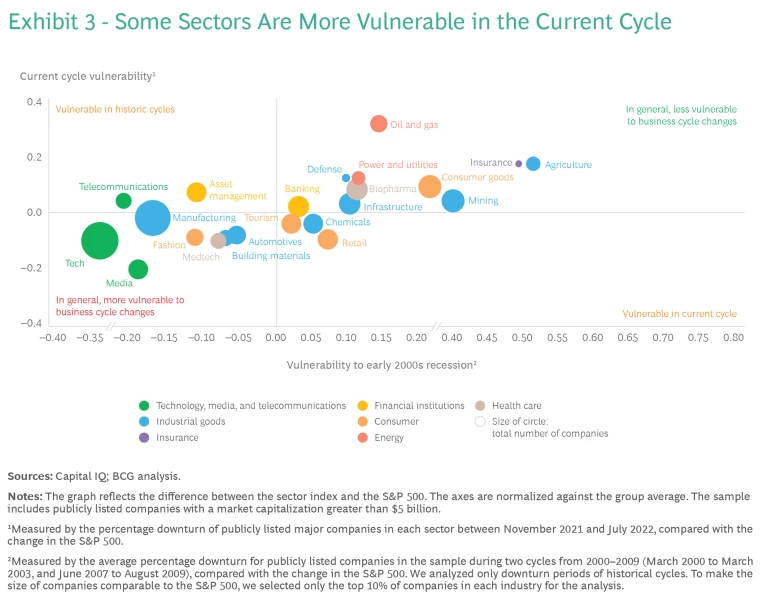
A recession would affect sectors in different ways. Some sectors (such as retail) are more vulnerable in the current environment than in previous recessions. (See Exhibit 3.) BCG’s analysis of the top 100 companies in the S&P 500 Retail Index showed an average margin compression of 194 basis points between the second quarters of 2021 and 2022.
What it means for procurement. To combat the pressure on profits, companies are exploring ways to increase margins. Although companies can maintain margins through pricing strategies and productivity improvements, procurement levers are among the least disruptive ways to boost profits.
An inflation-ready procurement function comprehensively considers categories of all sizes, utilizes strategies like hedging and price-indexing, and scrutinizes every price change. For example, a leading US retailer’s procurement function analyzed the impact of inflation to determine if a supplier’s proposed 10% price hike was justified by higher costs. The analysis showed that the real inflationary effect on the supplier’s costs was only 6%, enabling the company to negotiate 4% savings.
Conducting ideation workshops and joint collaboration sessions with business partners and suppliers can often lead to innovative ideas beyond the typical commercial levers, helping companies increase margins.
Trend #4: Adoption of Climate Sustainability Goals Is Accelerating
Governments worldwide are enacting stricter carbon
An increasing number of companies have responded by setting net-zero climate goals and pursuing decarbonization strategies. Approximately 21% of the world’s 2,000 largest companies have initiated forms of net-zero goals, and 400 signed “The Climate Pledge,” cofounded by Amazon, in which they commit to net-zero emissions by 2040—a decade ahead of the Paris Agreement’s goal of achieving carbon neutrality by 2050. Even beyond this select group, the desire to achieve sustainability targets is widespread—80% of companies aspire to improve sustainability, according to BCG research. However, we also found that only approximately 10% of companies have established the requisite enablers of sustainability, such as target-setting and funding.
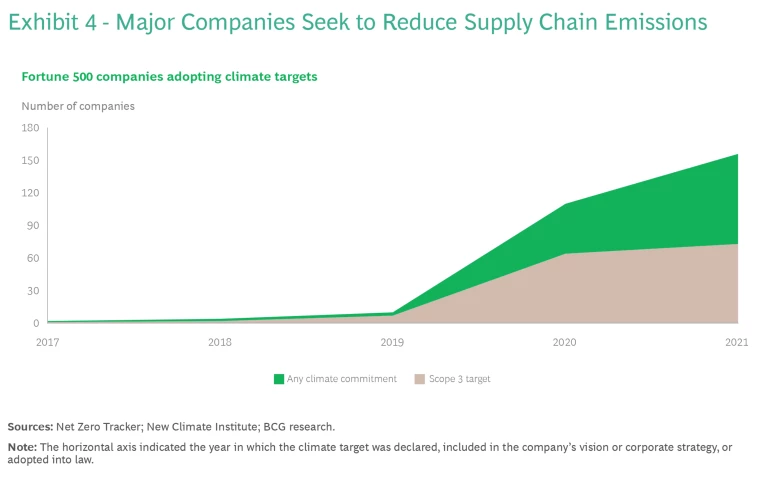
As businesses ramp up their efforts to address climate sustainability, reducing emissions generated by their supply chain (known as Scope 3 emissions) has become increasingly crucial. The number of Fortune 500 companies with a target to reduce Scope 3 emissions has risen from less than 10 in 2019 to more than 70 in 2021. (See Exhibit 4.) This trend is expected to continue.
What it means for procurement. Procurement functions play an essential role in helping companies achieve their climate goals. For example, a company must involve strategic suppliers in its sustainability initiatives. This includes requiring suppliers to commit to implementing green practices and reducing Scope 3 emissions as part of the tender process. Companies can also collaborate with suppliers to develop emissions-reduction plans. As discussed in our BCG colleagues’ book Profit from the Source, it is crucial for CEOs to empower their procurement leaders to make the most of suppliers’ expertise and resources, including with respect to meeting sustainability goals.
In addition, companies should emphasize the sourcing of sustainable raw materials. In the fashion industry, for instance, leading companies are exploring innovative uses of recycled or leftover materials in their products.
Trend #5: Companies Are Strengthening Their Commitment to Social Equity
Companies are increasingly seeking ways to address socioeconomic and political disparities. These disparities are pervasive and often stem from systemic issues. For example, the US Bureau of Labor Statistics reported that the median weekly earnings of full-time workers in 2020 were significantly lower for Hispanics and Blacks than for whites and
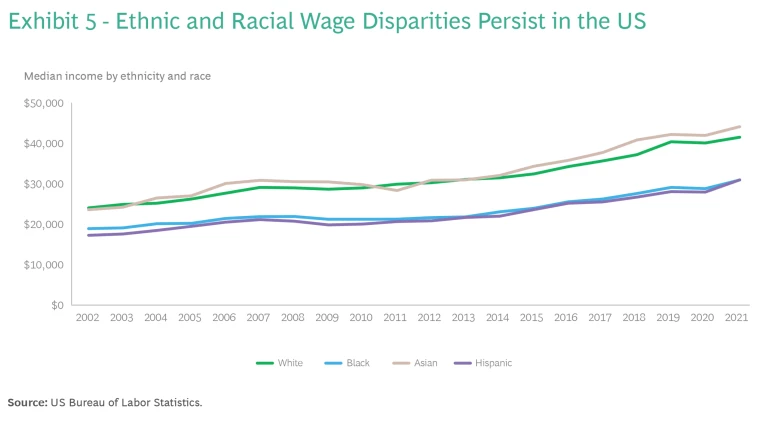
Looking at the gender gap, women comprise slightly less than 50% of the workforce but only hold 29% of senior executive positions at US companies. This gap broadens for larger companies—only 8% of the S&P 500 companies have women
Employees care about how their companies approach diversity, equity, and inclusion (DEI). In a survey by Workhuman, 66% of respondents said their company’s DEI strategy affects how long they will stay in their
What it means for procurement. Procurement strategies should include goals for giving opportunities to diverse suppliers—that is, businesses that are majority owned and operated by individuals or groups who are traditionally underrepresented or underserved. This might entail, for example, asking for information about a supplier’s diversity in RFPs or setting a target for the percentage of diverse suppliers used by the company. By partnering with diverse suppliers, companies can generate revenues for these organizations as well as income for their employees, thereby helping to close the wealth gap across minority populations.
Implementing DEI in procurement can be challenging for large companies because diverse suppliers struggle to build scale and capabilities. As our BCG colleagues detailed in a recent Harvard Business Review article, Google has successfully overcome this challenge by sponsoring diverse suppliers in alliances with established suppliers. The alliances help the diverse supplies grow capacity, gain capabilities, and take on senior management
Trend #6: Next-Generation Technology Is Promoting Efficiency
Companies are adopting next-generation procurement technologies to tackle the growing complexity of operations, increasing number of stakeholders and processes, and scarcity of skilled labor. Indeed, the use of artificial intelligence (AI), blockchain, and the Internet of Things (IoT) has become table stakes for procurement.
In a 2022 survey, IDC asked more than 1,100 procurement leaders which technologies they planned to implement during the next 12 months and three years. AI and blockchain showed the biggest increases in implementation over three years versus 12
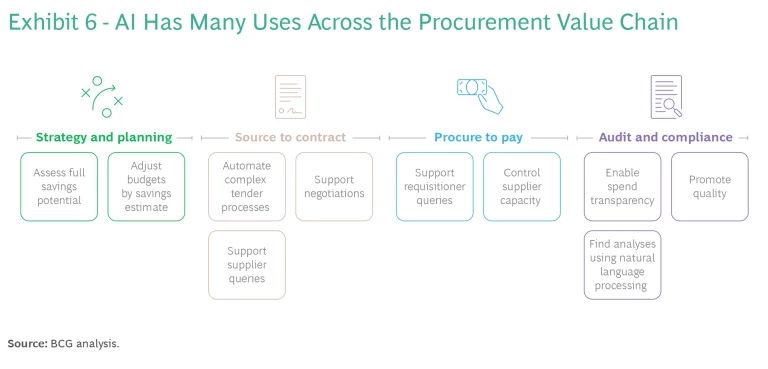
What it means for procurement. Organizations can implement these advanced technologies throughout the procurement value chain. There are many applications for AI across the procurement value chain. (See Exhibit 6.) For example, some procurement functions have started using generative AI (such as ChatGPT) to streamline workflows, reduce human error, and augment decision-making. The applications include automating contracts or request-for-proposal generation and forecasting demand. Using AI to automate decisions reduces redundant roles and frees up managers’ time for value-adding tasks.
It is crucial to target investments in next-generation technology to the achievement of specific business outcomes, such as improved inventory management. For example, BCG research finds that higher investments in AI as a share of all digital investments generate increasingly higher returns if these investments are intended to achieve specific outcomes.
Procurement functions that fail to adopt AI, blockchain, and IoT will be at a disadvantage. Industry giants such as Siemens, Lufthansa, Philips, and Henkel have already embraced these advanced technologies to automate procurement processes. Additionally, major organizations such as Walmart Canada, Emerson, and Corning have started using blockchain with their supply chain partners to gain end-to-end visibility.
Trend #7: Procurement Needs Specialized Skills but Faces a Talent Shortage
The adoption of new technology tools is changing the skill profile of procurement functions. In the coming years, the increasing use of standardization and self-service will reduce the need for negotiating, buying, and reporting skills. (See Exhibit 7.) Over the same period, procurement functions will need more category managers with capabilities to use advanced analytics and other innovations.
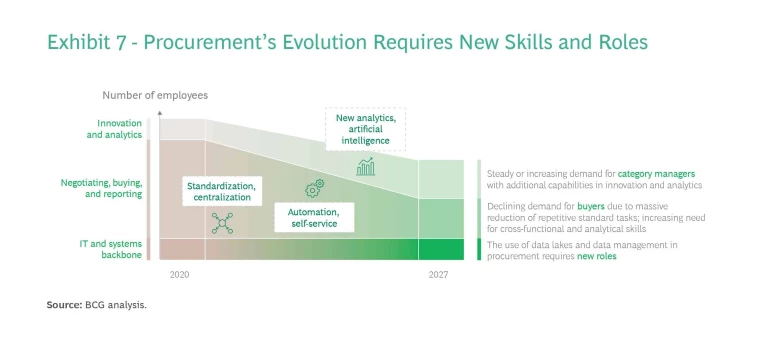
However, labor shortages in the aftermath of the pandemic have made it difficult for procurement leaders to attract the specialized talent required for their function’s evolving operation model. The talent gap is already evident in many organizations. In a BCG global survey of C-suite and board-level executives, 30% of respondents said that attracting and retaining talent is one of the top five issues affecting procurement. Additionally, 39% cited difficulty attracting, building, and retaining skills as one of the top five barriers to changing procurement. According to a study by SAP, only 41% of procurement teams possess the skills and abilities required to adopt new
What it means for procurement. Procurement leaders must assess their operating model and create a talent development plan that can support the overall procurement strategy. A well-balanced procurement team focuses on category management while striving to automate routine tasks, such as buying and contracting.
Stay ahead with BCG insights on operations
In addition, to gain a competitive edge, companies must continue to offer new perks such as work-from-home flexibility, competitive salaries, signing bonuses, location flexibility, and generous vacation time. A BCG survey found that 60% of all employees want some flexibility with respect to when and where they work. Reflecting this sentiment, a survey of procurement professionals in the UK by CIPS Group found that remote work and flexible working hours are the most desired
The recent volatility has made clear that CEOs must give procurement leaders a seat at the decision-making table. Rather than being a support function responsible for cost savings, procurement must take a leading role in managing risks, addressing crises, advancing sustainability, and improving quality. Strong collaboration with internal business partners and critical suppliers is essential for success. To enable this enhanced role, companies need to change their perception of procurement and invest in the function’s strategic capabilities. With this empowerment, procurement can extract maximum value from supplier relationships and help to steer the company through today’s volatile business environment.



